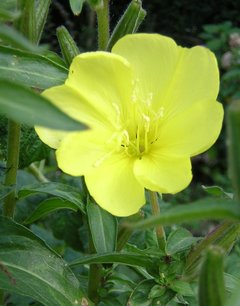Oenothera
|
|
| Oenothera | ||||||||||||
|---|---|---|---|---|---|---|---|---|---|---|---|---|
 | ||||||||||||
| Scientific classification | ||||||||||||
| ||||||||||||
| Species | ||||||||||||
|
See text |
Oenothera is a genus of about 125 species of annual, biennial and perennial herbs. It is the type genus of the family Onagraceae. They are known as evening primroses, and are native to North and South America (i.e. Blackfoot tribe).
It was assigned to the genus Onagra, which gave the family Onagraceae its name. Onagra -- meaning "(food of) onager" -- was first used in botany in 1587 and in an English publication in P. Miller's 1754 Gardeners Dictionary: Abridged. Its modern name Oenothera -- first used by Carolus Linnaeus in his Systema Naturę -- also has a donkey-related origin, meaning "ass-catcher". In Greek oeno means "donkey", while thera means "to catch, trap, pursue". It is believed that the name refers to the toxicity of the plant that can be used to trap donkeys and other animals. In 1860, William Baird suggests, however, that oeno could be interpreted as "wine" in Greek. He believes that it refers to the fact that the root of the edible Oenothera biennis was used as a wine flavour additive.
Oenothera biennis
O. biennis, also know as the common evening primrose and Evening Star, is a biennial plant growing to 1.2Metre, with easy germination. Its hermaphrodite pale yellow flowers (for most of the summer - from June to September - reaching a height of 3 to 4 feet) open in the evening, hence the name "evening primrose", are pollinated by Lepidoptera (Moths and Butterflies) and bees.
It originated in Mexico and Central America some 70,000 years ago. During the Pleistocene era a succession of ice ages swept down across North America, with intervening warm periods. This was repeated for four ice ages, with four separate waves of colonisation, each hybridising with the remnants of the previous waves. This generated a present day population which is enormously rich in genetic diversity, spread right across the North American continent. It's very popular in gardens, and is now also naturalised in parts of Europe and Asia. The first plants to arrive in Europe, reached Padua from Virginia in 1614 and were described by the English botanist John Goodyer in 1621. The plant is now naturalised in several parts of Great Britain.
The National Council for the Conservation of Plants and Gardens, based at Wisley, maintains a national Oenothera collection as part of its National Collections scheme.
Evening primrose must be planted in any ordinary, dry, well drained garden soil (preferly sandy loam) in an open site that is sunny to partly shady. It is drought resistant.
Oenothera_pollen.jpg
Scanning electron microscope image
For propagation, sow seeds in situ from late spring to early summer. The plant will grow successfully in fertile soils (such as gardens) if competing species are kept at bay. In the wild, evening primrose acts as a primary coloniser, springing up wherever a patch of bare, undisturbed ground may be found. This means that it tends to be found in poorer environments such as dunes, roadsides, railway embankments and wasteland. It often occurs as a casual, eventually being out-competed by other species. It grows as far north as 65° N in Finland.
Young roots can be eaten like a vegetable (with a peppery flavour), or the shoots can be eaten as a salad. The whole plant was used to prepare an infusion with astringent and sedative properties. It was considered to be effective in healing asthmatic coughs, gastro-intestinal disorders, whooping cough and as a sedative pain-killer. Poultices containing O. biennis were used to ease bruises and speed wound healing. One of the common names for Oenothera, "Kings cureall", reflects the wide range of healing powers ascribed to this plant, although it should be noted that its efficacy for these purposes has not been demonstrated in clinical trials.
The seeds ripen from August to October. The mature seeds of the evening primrose contains approximately 7-10% gamma-linolenic acid (gamma-linolenic acid), a rare essential fatty acid. The Onagra biennis seed oil is used to reduce the pains in the premenstrual stress syndrome.
External links
- http://www.botanical.com/botanical/mgmh/p/primro70.html
- http://www.ibiblio.org/pfaf/cgi-bin/arr_html?Oenothera+biennis
- http://www.birthscene.com/content.cfm?contentID=379
- http://permaculture.info/cgi-bin/eden?plant=4389
- http://forums2.gardenweb.com/forums/load/seed/msg1017271914130.html?1
- http://www.crocus.co.uk/?ContentType=Plant_Card&ClassID=1000000973&affiliate=tdde:Nachtkerzen
